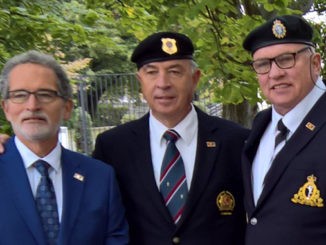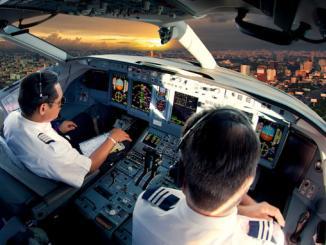
by Capt. Matt Sheehy & Capt. Steve Luckey
Eternal vigilance is the price of liberty – Wendell Phillips (1737-1809)
A flawed premise
Since the inception of airline travel, there’s been no method in place to know if the individual who purchased the ticket is actually the person getting on the airplane. This security gap exists despite identification checks which can be easily designed and employed.
A biometric match is probably the most efficient and reliable method of true identity verification. Databases are expensive, cumbersome and somewhat difficult to protect but there are other, more effective and efficient alternative security tools, especially with today’s computer power and advanced technology.
Define the threat
Threat is not about so called dangerous items, it’s all about intent. Co-author Luckey had the opportunity to work closely with ISA (Israel Security Agency), which protects Ben Gurion Airport and national airline El Al, securing valuable information in an environment that is probably the most highly targeted in the entire world. This experience has provided invaluable insight into asset protection.
The Israelis look at intent, not simply ‘stuff’ alone and do it very well indeed, as confirmed by their phenomenal success. If the security process triggers the need for advanced inspection, they bring technology and professional security techniques into play. They don’t waste these valuable assets unnecessarily.
The recent Transportation Security Administration (TSA) and Transport Canada (TC) directive relaxing restrictions on carry-on items is a step in the right direction, providing the level of trust in passengers is verified by a credible security system. A few years ago we developed a threat driven, trust based system called TABSS; “Trust Activated Biometric Security System,” in which the status and identity of passengers was based on a blend of behavioral science, technology and tactics that was difficult to defeat. It’s a layered approach in which the passenger becomes a security partner instead of a suspected adversary.
Taking defensive items away from trust-verified, well intended people doesn’t increase security, it may actually decrease it. If the 9/11 passengers had gone through effective trust-based security, the outcome could have been much different. These items are legal on El Al because it “trusts but verifies” passenger threat status through observation and interview techniques prior to boarding. Israel uses a layered behavioral observation system incorporating in-depth methods of behavioral science in addition to a visible technological security system.
Focus on intent
Flight attendants have legitimate concerns over relaxing restrictions on threat items and must be assured that a good trust-based security system based on determining intent may be more supportive. Passengers will no longer sit still and let another 9/11 attack occur in the aircraft cabin.
The argument that we repeatedly hear from the security establishment (TSA and CATSA – Canadian Aviation Transportation Security Agency) is that there are simply too many passengers to ever examine for hostile intent. This is the normal talking point of those who have a vested interest in preserving the status quo. The result of this inertia is that we have probably killed unknown thousands of people in automobile accidents who chose to drive millions of miles to escape invasive airport security processes.
Surveys have shown that if people can get to their destination in eight hours or less, they will drive rather than endure airport security. Statistically, highway driving is estimated to be as much as 20 times more dangerous than commercial flying.
This inane politically correct security theatre of doing everything to everybody to appear to be unbiased and fair is ridiculous, inefficient, very costly and negatively effects the entire industry. The damage inflicted by the lack of focus on good behavioral science is astounding. Although difficult to accurately quantify, people have turned away from air travel whenever possible to avoid the dreaded security process.
Estimates of lost passenger travel range somewhere between five and 10 per cent of total air travel revenue. This is even more significant when one realizes that the profit margin is less than one per cent overall. Global air travel industry is reported by IATA to be a $2.2 trillion dollar industry.
Solution – Trust & verify
Find and ID the no threat passengers and move them out of the queue. The answer is not to look at everyone as a potential security threat but to look for ‘good’ people, verify their trust status identity and remove them from the huge scrutiny group of travelers as rapidly and effectively as possible. This is a huge psychological win-win for everyone.
We know at least ten times as many ‘good’ people as those who would possibly do us harm. Good people are very transparent. Almost all people that we know personally pose little or no risk to aviation. As honest and now trusted travellers, we are entitled to protection from unlawful search and seizure under both the Canadian Charter of Rights and Freedoms and the US Constitution.
Luckey spent years researching and developing an electronic passenger pre-screening program called CAPPS (Computer Assisted Passenger Pre-Screening).
It became obvious that we know a lot about the individual traveler, based on the information available on the PNR (Passenger Name Record) provided by the person purchasing the ticket. Using this approach, we can analyze trust level, protect privacy, limit searches and actually make the entire security process an almost hassle-free experience that encourages people to actually want to fly, providing we do it correctly.
Note: CAPPS flagged nine of the 19 terrorists on 9/11. An enhanced version, CAPPS II, was cancelled in 2004).
The travelling public would perceive a trust and verify system as being fair and equitable and accept it as an intelligence driven approach to aviation security.
An electronic advanced classification scoring process can look for ‘good’ people, selecting and accurately scoring more than 95 per cent of the traveling public based on readily available, verifiable data. This “trust-but-verify” process can identify potential individual threat-status in advance. This data will provide information that can be used to quickly remove ‘good’ people from the huge scrutiny group.
The only caveat is that we still don’t know whether the individual represented is the actual passenger or an impostor; admittedly a challenge but hardly insurmountable. There is an inherent cost benefit to this new approach – double the flow-through = one half the cost (2XS (speed) = 1/2 C (cost)).
With the wide variety of biometric identification options, it’s not difficult to verify identity. All forms of biometric identification can be represented by an algorithm or line of computer code. We recommend the iris scan over many other methods such as facial recognition (Botox can play havoc with this) and fingerprints as this biometric can actually be compromised by some clever methodology. The accuracy of the iris scan biometric is outstanding.
The solution
The present NEXUS US-Canada cross border identification system is a current example of an effective and efficient system and clear proof of concept. People tend to object to touching things that others have touched and an iris scan only requires a quick look into a mirror-type device that requires no physical contact and involves no data base.
Pre-registering the individual’s eye geometry takes only a few seconds. It populates the reader looking for a match that agrees with an encrypted algorithm carried on some type of identification the individual carries. The information is very secure and remains the property of the traveler. There is no personal information stored on the card, just a reference number that verifies and IDs. A lost card is easily resolved with no loss of information or possibility of fraudulent use.
A typical scenario that could electronically signal an alarm: A passenger with no checked bag, travel history, credit rating or financial history pays cash for a one-way ticket. He/she may seem to glow in the dark as a potential threat passenger. A case in point was the underwear bomber, Umar Farouk Abdulmutallab, on Christmas Day 2009. The trust-but-verify system would have caught him..
However, there could be another explanation. Perhaps the passenger is an 18 year old military recruit going to boot camp and bought a ticket with cash borrowed from a relative. One simple question would clear up the alarm and he/she would be reclassified as a non-threat passenger. Developing advanced electronic scoring systems have shown that only about five per cent of passengers would ever need to be interviewed.
Technology can play a very important part in processing passengers when used properly. Making people stand in long lines, removing shoes and clothing items and taking out laptops is very inefficient and represents a negative experience. The success of red-team security inspections has shown that there are holes in even the best technology, but hiding intent from well trained security professionals can be very difficult. Combining various additional visual screening techniques adds significantly to the security process without inconveniencing the traveling public.
Issuing a personal encrypted identity RFID (Radio frequency ID) card, purchased and controlled by the individual, has proven to be a secure and attractive security option. The cost has come down over the years and people have shown they are willing to participate in these types of trusted traveler programs. Current US-Canada border crossing systems like NEXUS are now being used to also expedite travelers at selected airports.
Canada and the US have a joint travel initiative and signed agreement called “Beyond the Border”. Maybe it is time to effectively resource and support this program. This would not only benefit the long suffering traveling public but would bring a welcome financial bonus to the aviation and transportation industry.
.
Captain Stephen A. Luckey
Captain Matt Sheehy
.
BIOS
Captain Stephen A. Luckey is a retired 747-400 captain and decorated military pilot. A former chairman of the Air Line Pilots Association National Security Committee, he is an internationally recognized aviation security expert who testified in both US houses of congress on aviation security. Luckey is the founder of Jetana, LLC.
Captain Matt Sheehy is a retired airline pilot with 37 years experience with extensive expertise in aviation and transportation security. A former OPP A/Cst., he is presently the Canadian director of Jetana Security International Security Consultants.
.
First published Blue Line Magazine
.



